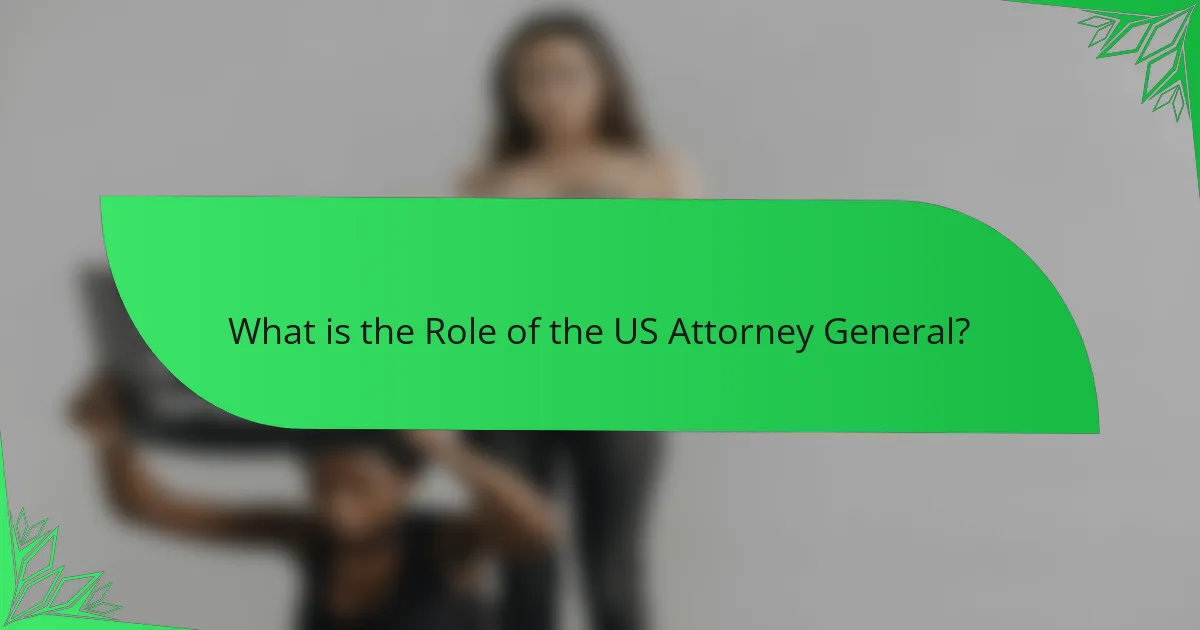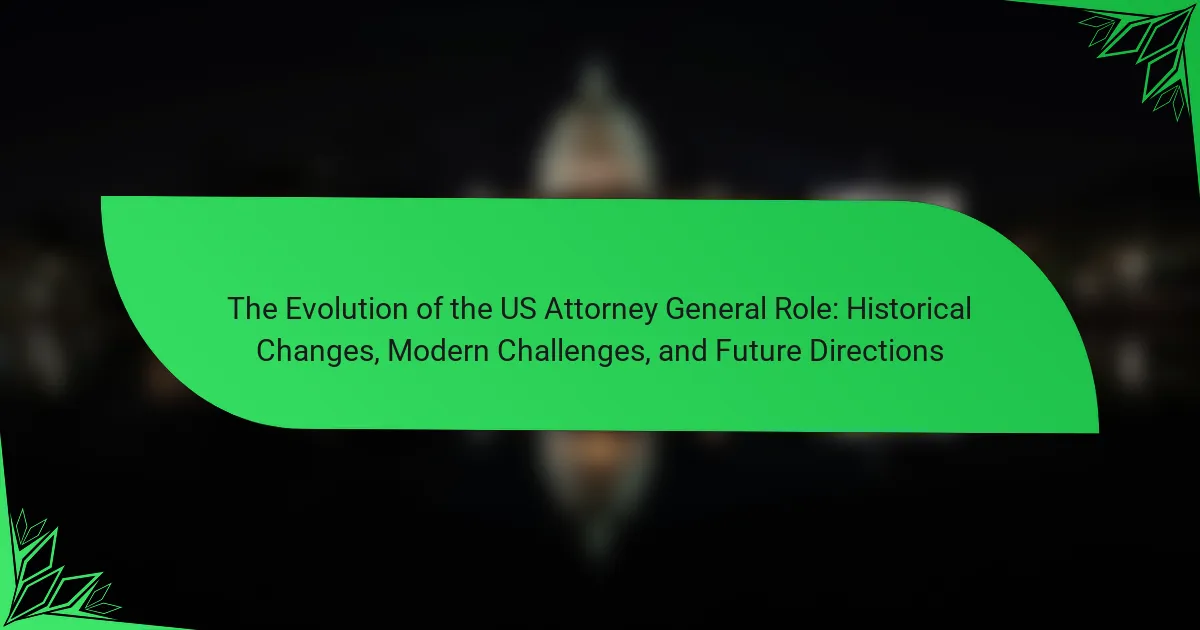The US Attorney General is the head of the Department of Justice, responsible for enforcing federal laws, providing legal counsel to the President and Cabinet, and representing the United States in legal matters. This article examines the historical evolution of the Attorney General’s role since its establishment in 1789, highlighting modern challenges such as political polarization, cybercrime, and civil rights issues. It also explores future directions for the position, including a focus on civil rights enforcement, climate change, and criminal justice reform. The discussion emphasizes the need for adaptive strategies in response to an evolving legal landscape and societal demands.

What is the Role of the US Attorney General?
The US Attorney General serves as the head of the Department of Justice. This role involves overseeing the enforcement of federal laws. The Attorney General provides legal advice to the President and the Cabinet. They also represent the United States in legal matters. The Attorney General is responsible for protecting the public interest. They lead federal criminal prosecutions and civil litigation. The position has evolved since its establishment in 1789. The Attorney General also addresses modern challenges like cybersecurity and civil rights.
How has the role of the US Attorney General evolved over time?
The role of the US Attorney General has evolved significantly since its establishment in 1789. Initially, the Attorney General served primarily as a legal advisor to the President and the Cabinet. Over time, the position expanded to include oversight of federal law enforcement agencies. In the 20th century, the Attorney General began to take on a more prominent role in civil rights issues and public policy. Significant events, such as the Civil Rights Movement, shaped the responsibilities of the office. Today, the Attorney General addresses complex challenges, including cybersecurity and immigration enforcement. The role now involves balancing legal, political, and social responsibilities. This evolution reflects changes in societal needs and the increasing complexity of law enforcement.
What are the key historical milestones in the development of the Attorney General’s role?
The role of the Attorney General in the United States has evolved significantly since its inception. The first Attorney General, Edmund Randolph, was appointed in 1789. This marked the establishment of the position within the executive branch. In 1820, the role began to gain more authority as the Department of Justice was created. The Attorney General’s responsibilities expanded further in the late 19th century, particularly under President Ulysses S. Grant, who emphasized law enforcement.
In 1933, Attorney General Homer S. Cummings took significant steps to modernize the office and enhance its role in federal law enforcement. The role continued to grow during the civil rights movement, with Attorneys General like Robert F. Kennedy advocating for civil rights protections. The Watergate scandal in the 1970s led to increased scrutiny of the office and its independence.
In the 21st century, the role has adapted to address issues like terrorism, cybersecurity, and drug policy. Each milestone reflects a shift in the legal landscape and the responsibilities of the Attorney General in upholding justice.
How did early perceptions of the Attorney General differ from today?
Early perceptions of the Attorney General focused on limited legal advisory roles. Initially, the position was seen as primarily a legal counsel for the government. Over time, this perception evolved to include broader responsibilities in law enforcement and public policy. Today, the Attorney General is viewed as a key figure in protecting civil rights and enforcing federal laws. This shift reflects the increasing complexity of legal and social issues in society. Historical context shows that early Attorneys General had less influence on national policy compared to their modern counterparts. The role has transformed to address contemporary challenges, such as cybersecurity and healthcare law.
What are the primary responsibilities of the US Attorney General?
The primary responsibilities of the US Attorney General include overseeing the Department of Justice. The Attorney General serves as the chief law enforcement officer of the federal government. They represent the United States in legal matters and advise the President on legal issues. The Attorney General also ensures the enforcement of federal laws. They manage federal prosecutors and oversee criminal investigations. Additionally, the Attorney General protects civil rights and oversees immigration enforcement. This role includes shaping national legal policy and addressing significant legal challenges.
What legal authorities does the Attorney General possess?
The Attorney General possesses the authority to enforce federal laws. This includes overseeing federal prosecutions and representing the United States in legal matters. The Attorney General also provides legal advice to the President and federal agencies. Additionally, the Attorney General can initiate investigations into violations of federal law. This role includes the ability to issue subpoenas and conduct legal hearings. The Attorney General has the power to intervene in cases involving federal interests. Furthermore, the position allows for the regulation of federal law enforcement agencies. These authorities are derived from the Judiciary Act of 1789 and various federal statutes.
How does the Attorney General influence federal law enforcement?
The Attorney General influences federal law enforcement through oversight and policy direction. The Attorney General heads the Department of Justice (DOJ). This position allows for the implementation of federal laws. The Attorney General sets priorities for federal law enforcement agencies. These agencies include the FBI, DEA, and ATF. The Attorney General can initiate investigations and prosecutions. This role also involves advising the President on legal matters. The Attorney General’s decisions shape the enforcement of laws across the nation. For instance, the Attorney General can influence enforcement priorities on issues like immigration or drug policy.

What Modern Challenges Does the US Attorney General Face?
The US Attorney General faces significant challenges today, including issues of political polarization. This polarization affects the perception and effectiveness of the Department of Justice. Additionally, the rise of cybercrime presents complex legal challenges. Cybercriminals operate across jurisdictions, complicating prosecution efforts. The Attorney General also confronts evolving drug-related issues, particularly with opioids and marijuana legalization. These challenges require updated legal frameworks and enforcement strategies. Furthermore, the Attorney General must address civil rights concerns amid social justice movements. These demands necessitate a balance between law enforcement and community trust. Each of these challenges reflects broader societal issues impacting the role of the Attorney General.
How do political dynamics impact the role of the Attorney General?
Political dynamics significantly influence the role of the Attorney General. The Attorney General often aligns with the political party in power. This alignment affects priorities in law enforcement and legal interpretations. For instance, during Democratic administrations, there may be a focus on civil rights and consumer protection. Conversely, Republican administrations might prioritize national security and immigration enforcement.
Political pressures can also impact decisions on prosecutions and investigations. Attorneys General may avoid pursuing cases that could be politically sensitive. Historical examples include the reluctance to investigate political allies or donors. Additionally, political dynamics shape the budget and resources allocated to the Attorney General’s office.
These dynamics can lead to changes in policy and legal strategy over time. Public opinion and political trends further influence the Attorney General’s effectiveness. Overall, the role is shaped by the intersection of law, politics, and public sentiment.
What challenges arise from partisan politics in the Attorney General’s office?
Partisan politics in the Attorney General’s office leads to significant challenges. It can result in biased legal interpretations and enforcement priorities. This bias undermines the impartiality expected from the office. Political pressures may influence decisions on investigations and prosecutions. Such challenges can erode public trust in the legal system. Historical examples show that partisan AGs may prioritize party interests over justice. This has led to accusations of politicization and conflicts of interest. Ultimately, partisan politics complicates the Attorney General’s ability to serve all citizens fairly.
How does public opinion shape the actions of the Attorney General?
Public opinion significantly influences the actions of the Attorney General. The Attorney General serves as the chief legal officer and is accountable to the public. When public sentiment leans towards specific issues, the Attorney General may prioritize those areas. For example, high-profile cases often arise from public outcry, prompting legal action. Additionally, public opinion can shape policy decisions and enforcement priorities. Surveys and polls are tools used to gauge public sentiment on legal matters. Historical instances, such as civil rights cases, illustrate how public pressure led to decisive actions. Overall, the Attorney General must balance legal responsibilities with public expectations.
What are the implications of technology and cybercrime for the Attorney General?
Technology and cybercrime significantly impact the role of the Attorney General. The Attorney General must address the increasing frequency of cybercrimes, such as identity theft and hacking. This requires updated legal frameworks to prosecute offenders effectively. Additionally, the Attorney General oversees cybersecurity policies to protect sensitive data. Coordination with federal and state agencies is essential for combating cyber threats. The rise of technology also necessitates public awareness campaigns on cyber safety. Moreover, the Attorney General faces challenges in balancing privacy rights with security measures. These implications highlight the evolving responsibilities of the Attorney General in the digital age.
How is the Attorney General addressing issues related to cybersecurity?
The Attorney General is addressing issues related to cybersecurity through proactive legal measures and policy initiatives. The office has established task forces focused on combating cybercrime. These task forces collaborate with federal, state, and local agencies. They aim to enhance information sharing and response strategies. The Attorney General also emphasizes public awareness campaigns about cybersecurity threats. Additionally, the office is involved in legislative advocacy for stronger cybersecurity laws. Recent reports indicate an increase in resources allocated to cybersecurity efforts. This approach reflects the growing importance of cybersecurity in protecting national interests.
What role does the Attorney General play in regulating emerging technologies?
The Attorney General plays a crucial role in regulating emerging technologies. This role includes enforcing laws related to privacy, data protection, and consumer rights. The Attorney General also investigates potential abuses of technology, such as fraud or discrimination. Additionally, the Attorney General provides guidance on compliance with federal and state regulations. In recent years, this role has expanded to address issues like artificial intelligence and cybersecurity. The Attorney General collaborates with other governmental agencies to establish best practices. This collaboration aims to ensure that technology is used responsibly and ethically. Overall, the Attorney General’s involvement is essential for balancing innovation with public safety and consumer protection.

What Future Directions Can We Anticipate for the US Attorney General?
The future directions for the US Attorney General include a focus on civil rights enforcement and combating climate change. The role will likely expand to address emerging technologies and cybersecurity threats. Increased scrutiny of corporate practices is anticipated as well. The Attorney General may also prioritize criminal justice reform initiatives. These directions align with current societal and political trends. The evolving legal landscape demands adaptive strategies from the Attorney General’s office. Recent statements from officials indicate a commitment to these priorities. Historical context shows that the role has adapted to meet pressing national issues.
How might changes in legislation affect the role of the Attorney General?
Changes in legislation can significantly alter the role of the Attorney General. Legislative changes can expand or limit the powers granted to the Attorney General. For instance, new laws may introduce additional responsibilities, such as overseeing new regulatory frameworks. This could require the Attorney General to enforce laws in emerging areas like technology or environmental protection. Conversely, legislation may also restrict the Attorney General’s authority, limiting their ability to pursue certain cases or initiatives. Historical examples include the establishment of the Consumer Financial Protection Bureau, which shifted some regulatory responsibilities away from the Attorney General. Additionally, changes in state laws can affect the Attorney General’s role at the state level, influencing their priorities and focus areas. Overall, the evolving legal landscape directly impacts the scope and effectiveness of the Attorney General’s office.
What potential reforms are being discussed in Congress?
Potential reforms being discussed in Congress include changes to the oversight of the Department of Justice. Lawmakers are considering measures to increase transparency and accountability. This includes proposals for enhanced reporting requirements on investigations and prosecutions. Additionally, discussions focus on reforming sentencing guidelines to address disparities. There are also talks about improving access to legal resources for underserved communities. These reforms aim to modernize the role of the Attorney General in response to contemporary challenges.
How could evolving legal interpretations impact the Attorney General’s authority?
Evolving legal interpretations could significantly impact the Attorney General’s authority. Changes in judicial rulings can redefine the scope of legal powers. For example, interpretations regarding federal versus state jurisdiction may alter enforcement capabilities. Additionally, evolving interpretations of constitutional rights can influence prosecutorial discretion. Historical cases, such as United States v. Nixon, demonstrate how legal interpretations can limit executive power. As new laws emerge, the Attorney General may face challenges in adapting to these shifts. This evolving landscape requires continuous reassessment of legal strategies and authority. Ultimately, the dynamic nature of legal interpretations directly shapes the effectiveness of the Attorney General’s role.
What strategies can the Attorney General adopt to meet future challenges?
The Attorney General can adopt several strategies to meet future challenges. First, enhancing collaboration with state and local law enforcement is essential. This can improve resource sharing and streamline responses to emerging threats. Second, investing in technology and data analytics can help the Attorney General’s office stay ahead of criminal activities. Utilizing advanced tools can enhance investigations and prosecutions. Third, focusing on public engagement and education can build community trust and cooperation. This can lead to more effective crime prevention strategies. Additionally, prioritizing diversity and inclusion within the office can ensure a broader perspective in addressing legal issues. These strategies align with the evolving role of the Attorney General in addressing complex legal landscapes.
How can the Attorney General enhance collaboration with state and local law enforcement?
The Attorney General can enhance collaboration with state and local law enforcement by establishing regular communication channels. This involves creating task forces that include representatives from various jurisdictions. Additionally, the Attorney General can provide resources and training to local law enforcement agencies. These resources may include funding for technology and personnel. The Attorney General can also facilitate information sharing regarding crime trends and best practices. Strengthening partnerships through community engagement initiatives can further improve collaboration. Historical data shows that such collaborative efforts reduce crime rates effectively. For instance, the Department of Justice’s Community Oriented Policing Services program has successfully fostered collaboration across jurisdictions.
What best practices can the Attorney General implement to improve public trust?
The Attorney General can implement transparency initiatives to improve public trust. Regularly publishing reports on activities and decision-making processes fosters accountability. Engaging with community stakeholders enhances communication and builds relationships. Establishing independent oversight mechanisms can ensure unbiased evaluations of actions. Conducting public forums allows citizens to voice concerns and ask questions. Providing accessible legal resources helps demystify the role of the Attorney General. Implementing training programs on ethics for staff promotes integrity within the office. Finally, responding promptly to public inquiries reinforces a commitment to openness and responsiveness.
What are the key takeaways regarding the evolution of the US Attorney General role?
The US Attorney General role has evolved significantly since its inception. Initially, the role focused on legal advice to the President and federal government. Over time, it expanded to include enforcement of federal laws and civil rights protections. The Attorney General’s responsibilities now encompass a wide range of issues, including drug enforcement and national security. Landmark cases and legislation have shaped the role, such as the Civil Rights Act of 1964. The position has also adapted to modern challenges, like cybercrime and immigration. The Attorney General is now a key figure in shaping national policy. This evolution reflects broader societal changes and legal developments in the United States.
The primary entity of this article is the US Attorney General, who serves as the head of the Department of Justice and oversees the enforcement of federal laws. The article outlines the historical evolution of the Attorney General’s role since its establishment in 1789, highlighting key milestones and the expansion of responsibilities, including civil rights protection and modern challenges like cybersecurity. It also examines the impact of political dynamics, public opinion, and emerging technologies on the Attorney General’s authority and effectiveness. Additionally, the article discusses potential future directions for the role, including reforms and strategies to enhance collaboration with law enforcement and improve public trust.
